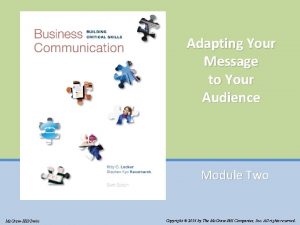Making Strong Arguments Adapting to your Audience Adapting







- Slides: 7

Making Strong Arguments Adapting to your Audience

Adapting to the Audience Ø Listeners are not passive in persuasive process l l l Ø Mental give-and-take Assessing credibility, delivery, support, reasoning Positive at one point; negative at another Speaker should anticipate objections l l Put self in audience’s place to identify issues Build in counter-arguments

Identifying Target Audience Ø Review audience analysis – For example: l Would you donate your organs after death? • • • l Of the 15, reasons for not donating • • • l 3 – strongly oppose no matter what 15 – neutral or only slightly opinionated 4 – already have signed donor cards 7 – fear of being pronounced dead prematurely 5 – fear of being disfigured 3 – religious reasons Additionally, 8 of the 15 didn’t understand need for donors.

Using Audience Analysis: Persuading a Receptive Audience Establish common ground (in introduction) Ø Clearly state speaking objective Ø Tell audience what you want them to do Ø Ask for an immediate show of support Ø Use emotional appeals effectively to motivate and intensify their support (basic values and needs appeals) Ø Create a sense of personal involvement Ø Make it easy for audience to act Ø Prepare audience to carry message to others Ø

Persuading a Neutral Audience Capture audience’s attention early in speech and use plenty of attention factors throughout speech Ø Refer to beliefs that many listeners share (common values, concerns) Ø Relate your topic to listeners, their families, friends, loved ones Ø Be realistic about what you can accomplish Ø Blend logic and emotion, but use emotional appeals sparingly Ø

Persuading an Unreceptive or Hostile Audience Ø Ø Ø Ø Ø Don’t immediately announce your intentions Stress common ground & agreement areas Establish your credibility Create a context of increasing understanding Acknowledge opposing points of view and then refute them with respect Use strong evidence and reasoning – virtually not emotional appeals Don’t overstate your points If their position rests on a principle, present a counter principle. Don’t expect a major shift in attitude

Don’t Aim for Conversion Ø Chip away at edges Ø Identify inconsistencies in their position Ø Employ consciousness raising tactics – i. e. the higher ground Ø Seek incremental change Ø Use reluctant testimony













